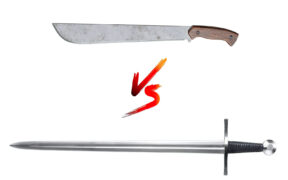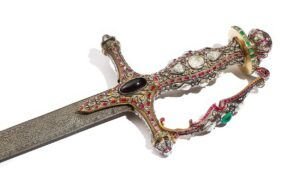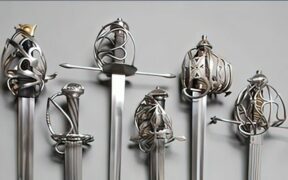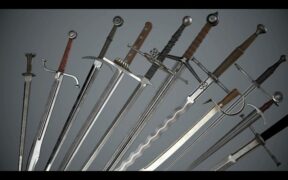Our content features commercial links to our products, committed to transparent, unbiased, and informed editorial recommendations. Learn More
Machete Swords: Types, Characteristics and History
NO AI USED This Article has been written and edited by our team with no help of the AI
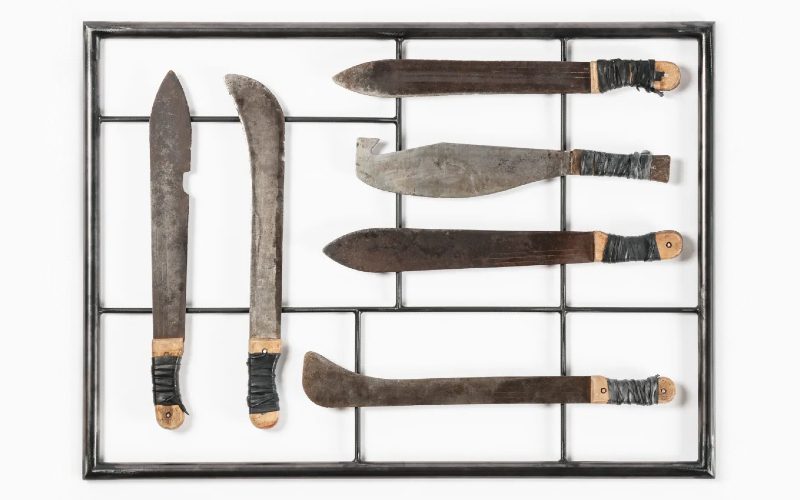
The machete of today is a broad, short, and heavy sword, but it originated from the Stone Age. It can be used for many kinds of activities. It is very popular, and there are many types.
In this article, you will find everything you need to know about the machete. First, you will learn about all the different types and their general characteristics. Then you will find out how this sword is used correctly and for what purposes. Finally, we will end by talking about its long history.
Types of Machete Swords
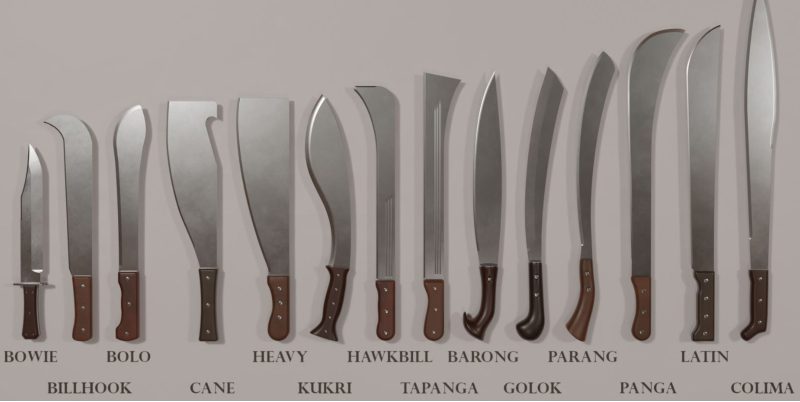
There are various kinds of machetes. The machete has been used for a long time in many rural parts of the world. Over its long history, it has changed in style, shape, and function to suit different uses and environments. As a result, names and designs vary from place to place and often overlap.
In different places, you might notice similar machetes mentioned by other names. Here we will note all the types of machetes and all their possible names.
Barong Machete

The blade of a Barong machete is shaped like a leaf and is usually only honed and sharpened on one side, making it a one-edged blade. The Barong was a cutting tool used by some tribes in the Philippines. However, European colonists feared it because the machete could cut through musket barrels.
Sometimes you will be able to find this type of machete under the names of Rawit or Barung.
Bolo Machete

The Bolo machete is well-known throughout Southeast Asia and is often used as a tool for farming and gardening. For example, a Bolo machete is a great tool for harvesting narrow crops like rice, soybeans, peanuts, and mung beans. This is because the fore blade has a bulge that makes it heavier and gives it more cutting power.
Even traveling across these lands, you will see farmers wielding the Bolo machete in their farming activities, as it is a very handy tool.
Billhook Machete

The Bilhhook machete is an old cutting tool and is mostly used in agriculture in the present and past. It has a curved blade for cutting around things like tree trunks and “snedding,” which is the process of removing lower branches and buds from a branch.
The hooked blade, which is sharpened on the inside curve, is perfect for grabbing vines and brambles and cutting them. They are also used in cutting wooden materials when constructing or building something.
You can sometimes find this machete used by its other names – Coa, Sheaf Hook, Bagging Hook, or Reaping Hook.
Latin or Bush Machete

This popular Bush machete blade has a normal and straight back, making it an all-purpose machete. The blade is usually well-balanced and rather thick. It’s easy to put a sheath on it so you can carry it around.
It is usually seen in Latin America since it traces its origins from there. It is an all-purpose tool mostly used for cutting vegetation, especially when clearing out big forested areas in South America. However, it was sometimes used in combat scenarios too.
The most common name for this type is the Latin machete.
Colima Machete

Colima machetes are sharpened across both edges of the blade so that both forehand and backhand cuts can be made with a sweeping motion. Most Colima machetes are heavier on the back so that they can be used to clear on the backstroke.
The hunchbacked look of this machete makes it a very effective slashing tool. It is great for mowing large ranges of vegetation but has also been used very powerfully in combat situations.
It comes from Central America, and you can sometimes see it under Acapulqeno, Costeno, Panzon, and Caguayano.
Cane Machete

Cane machetes usually have blunt tips that are great for cutting through sugar cane, bamboo sticks, rice, and corn stalks. Usually, the blade has a hook on it so that the person using it can pull the cut cane away from the plants that are still standing. The thinness of the blade makes it easy to cut through cane-like plants.
It is a very handy tool in agriculture and also good for slashing. It is almost as if it was meant to be used by a butcher for chopping meat. It is sometimes called the Corn knife, Cleaver, or Machete de Suelo.
Hawkbill Machete

This machete with a curve or hook can be sharpened across both sides or inside the curve. The sharpened tip of the Hawkbill can pierce and cut through very hard materials by concentrating pressure and power on a sharp point. The inner curve makes it easier to harvest and collect plants with stalks.
Usually, you see this type of machete in movies where the protagonist is cutting through tall grasses in either jungles or forested areas. It is highly effective for this purpose too.
This machete is sometimes called the Cuma machete.
Parang Machete

The Parang machete has a distinctive curved shape where both the spine and edge are curved, like a scimitar. Most of the time, these machetes are long, have a thick blade, and are either slightly heavier or about the same weight throughout.
It originated in Indonesia and was a very useful tool for agriculture and farming, but it was especially effective for cutting wooden materials. This is because it can cut the wood without getting lodged and stuck.
Sometimes it’s called Golok, Sable, or Bedog.
Panga Machete

The style of panga machete is common in Africa and the Caribbean. The blade’s deep belly gives it mass, weight and power for chopping and slicing. The point can be used to cause pressure and pierce through one tiny spot.
It is believed that it comes from Africa and was highly utilized in chopping down very thick vegetated areas that are extremely hard to walk through.
Sometimes it is also called a Daga, Liniero, Rozador, or Burriquito machete.
Heavy Machete

This is the most important machete for work that requires brute force. When you hear the words “weighted” or “heavy,” consider how the mass is distributed in the design of the blade. The bulk of the weight on the heavy or weighted machete is at the top of the blade, making it easier to cut through thick and woody plants.
It is called a Heavy machete primarily because of its looks and weight.
Bowie Machete

The clip-point or fowler skinner tip on the Bowie machete is used to skin wild game. This style is popular among survivalists and people who live in the woods. It is named after the American frontiersman Jim Bowie, which is why it is believed to come from the US.
It is a highly utilized tool for survival. Even hunters have a Bowie knife strapped on their belts at all times. Therefore, it is the perfect tool to carry when you are alone in a forest.
This machete is sometimes called a Large or Big Bowie Knife, the Wilderness Machete, or better yet, the Survival Machete.
Kukri

The Kukri sword, which is also called the Khukuri, is a Nepalese sword with a curved edge that follows the length of the blade. In Nepal, it is used as both a weapon and a tool. But Nepalese people have used it for a long time as a basic utility knife, and because of how effective it is, it spread around the globe.
This Kukri is sometimes called a machete Kukri. This is because they have a similar shape and are used for the same purposes but have very different histories and origins.
General Characteristics of Machete Swords
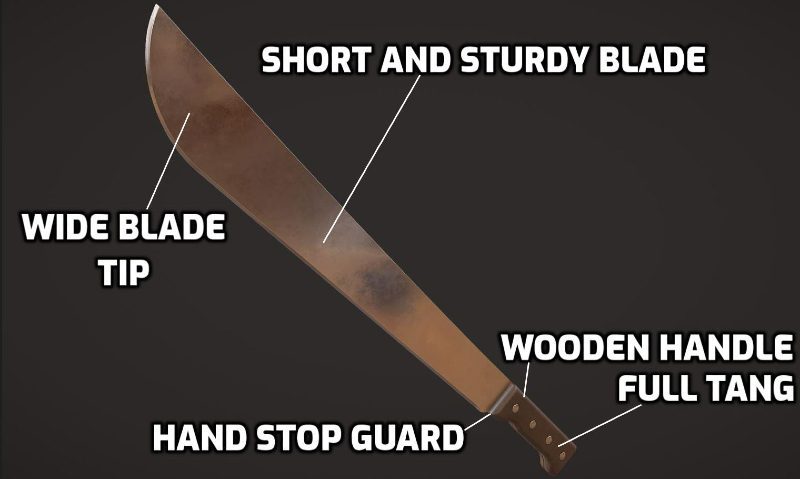
The machete sword will generally have the same shape and overall feel as though they have the same characteristics. They are small, stiff, slightly unorthodox curved-shaped, and can pack a punch.
Blade
The blade length for the machete swords will most likely range from 11 to 17 inches (30 to 45 cm).
Of course, this blade will vary depending on the different types of machetes available. However, they all have in common that they are short and slightly curved, with the back end sort of hunchbacked in some of them. This curvature and shape offer the machete much power and ways to be used.
A machete should be full tang. The blade needs to extend all the way through to the end of the handle, then be fastened in place to enable it to chop and slice with force. This will result in a much stronger blade that will be less likely to break.
The primary way to distinguish one machete from another is by the kind of material used to make the blade. Both stainless steel and high-carbon steel are often used in the production of blades. The benefits of stainless and carbon steel blades are combined in one material known as high-carbon stainless steel.
Guard
The machete swords or knives don’t really have a guard that would resemble a normal-looking guard of a sword. It does, however, have a little part at the top of the handle that resembles a guard.
This is called a hand stop guard and ensures a better overall grip. You will feel the hand stop when holding the machete with one hand. This will enable you to hold the sword without fearing that you may drop it.
It does not, however, provide any protection to your hands or fingers at all.
Handle
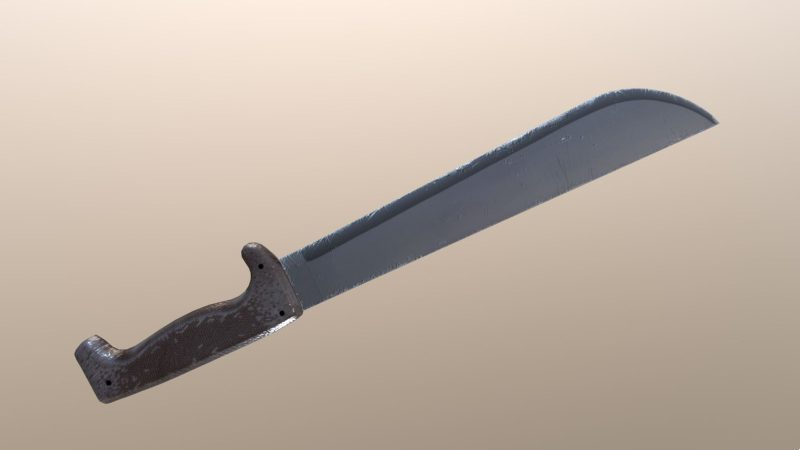
Most machete handles are simple. They have a hand guard to keep the user’s hand from slipping onto the blade and a hand stop at the bottom to keep the user’s hand from falling off the back and losing control of the sword.
The material for the handle is made from wood, rubber, and polymer.
- Wooden handle – it offers excellent grip and comfort. It feels strong and lightweight and is also long-lasting. But if not taken care of properly, especially from moisture, the wood handle may crack.
- Rubber handle – it allows for a perfect grip. You can add visual elements to make the handle look fantastic and visually pleasing to your needs. The rubber is a great element to absorb some of the vibrations. However, it is not long-lasting and can tear with time.
- Polymer handle – it is the most inexpensive type of handle. It offers a good grip and does not need a lot of maintenance. But with time, it can become slippery from use, especially if it becomes wet. It can also cause potential discoloration from use.
Scabbard
The scabbard for the machete swords is usually made from leather or sturdy woven nylon. The leather sheath is easy to carry around and won’t damage the scabbard if it is made of wood, for example. However, a nylon sheath is also convenient.
It can be as long as the blade. Sometimes the end of the scabbard, where the blade tip is, is made of plastic to prevent stabbing something by mistake.
Size & Length
The overall length of the machete sword is usually around 18 inches (45 cm) long.
Since there are many types of machete swords, the sizes can vary. You may sometimes find a machete that can be as small as 10 inches (25cm) or as long as 28 inches (71 cm).
The size of the machete depends on its use. For example, if the machete is made for cutting tall grass, it will be longer. However, if it is made for cutting through wood, it will need to be shorter and sturdier to offer more power.
Weight
The average weight of the machete sword is about 1.4 to 1.5 pounds (650 to 700 grams).
This can vary from 0.7/0.9 to 2.8 pounds (350/400 grams to 1.3 kg) depending on the type of Machete.
Overall it isn’t such a heavy sword, and because of its short size and strong grip, you won’t feel its weight. It feels like a knife when held in your hand but has the power of a sword and axe combined.
Uses for the Machete Sword
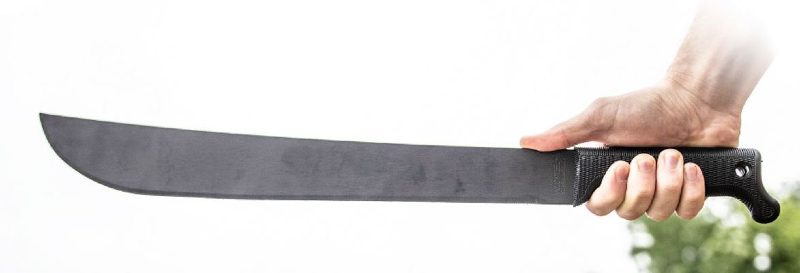
The machete shape is made in such a way that it will be considerably more useful than a regular sword. It will almost be as if you have a knife, sword, axe, and even sometimes a hammer because of the blunt edges of some types.
It is best used as a one-handed sword because it offers a very strong grip. But you can also seize it with both hands for a much stronger and more precise strike.
Although it is highly useful for all sorts of situations, it is mostly used for agriculture and warfare.
Agriculture
In agriculture, the machete is often used to cut sugar cane, as well as to cut through weeds. The jungle machete types are also good for clearing out entire sections of unpassable areas.
Also, people throughout the globe have used the machete to chop multiple meals into pieces, like we would employ a cleaver, or to do simple cutting jobs, like working with all sorts of wooden materials, or for many other activities too. People might also use a machete to open coconuts, do yard work, or get rid of brush vegetation.
You will see it even strapped on a farmer’s back or belt in the US. A machete isn’t illegal in the US and is considered a tool. The farmer will carry it around him wherever he goes doing this daily work. It is a very handy tool and something that many agricultural workers cannot function without.
Warfare

The tactical machete types can be employed as a weapon because they are strong and can be used in many ways. They are used very effectively in all sorts of wars. In addition, the curved shape of the blade can cut through flesh and possibly even through bones.
In modern days, the Kukri, for example, is the Gurkha’s right arm (the Gurkha are Nepals’ special forces). It is not just their symbol but also a weapon they always carry with them for self-defense. Even in the modern era, the machete has been used in major battles. For example, in the battle of Havana, peasant guerrillas took their agricultural tool – the machete – and used it to defend the city.
There are also many martial art schools in the world that teach how to use a Machete for combat purposes. Even its tactics are being studied in militaries.
Modern hunters prefer the machete sword over a small hunting knife if they venture into a remote wilderness surrounded by all sorts of animals. It is an amazing survival tool to own.
Symbolic
Because of how useful this sword has proven to be through the ages, in terms of both getting food to the table and providing defense, it has grown to be a significant symbolic piece in many cultures throughout the world, especially in Latin America and South East Asia.
The machete symbol is seen as a symbol of a uniform military. Sometimes it was even used to represent the fight against oppression. It is also placed on some countries’ flags, like Angola.
Rio Grande do Sul, a state in southern Brazil, has a dance called the ‘danca dos faces’, which means “dance of the machetes.” The choreographers, usually men, clock their machetes against different surfaces while dancing to make it look like they are fighting.
History of the Machete Sword
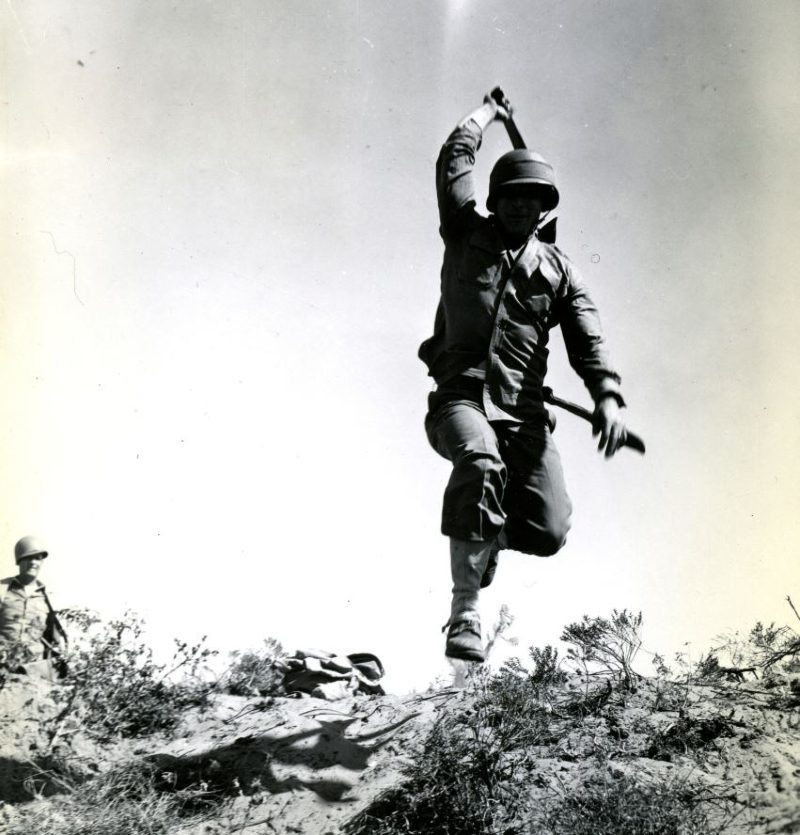
Even though it’s hard to say who created the first machete, many people claim to have the answer. However, machetes have changed along with people and the evolution of humankind.
The origins of the machete sword can be traced to cavemen. Cave dwellers made weapons like machetes from stones to protect themselves and for hunting. During the first settlements, the machete was used a lot for farming, fighting, and even building. So we can confidently say that it comes from the Neolithic Era (10.000 to 5.000 BC).
Indeed, this incredible instrument has significantly aided several civilizations throughout history. Here are some instances of people who were fans of the machete:
- Ancient Greece – Kopis sword
- Germanic Tribes – Seax sword
- Malaysian – Parang sword
- Ancient Egypt – Kopesh sword
- Iberian tribes – Falcata sword
Some say the machete sword was originally made in the Iberian peninsula in ancient times. They claim the machete comes from the Roman word for the Greece and Iberian curved sword – the Machaira sword.
Some trace the modern-looking machete shape and characteristics to the machete from ancient Iberia or Spain. The word machete comes from the Spanish word macho – which means sledgehammer or it has something to do with masculinity.
Conclusion
The machete sword could be the world’s oldest type of blade. It has seen many stages of the human evolution, and it is still a very remarkable tool and weapon that is very used and popular even today.
